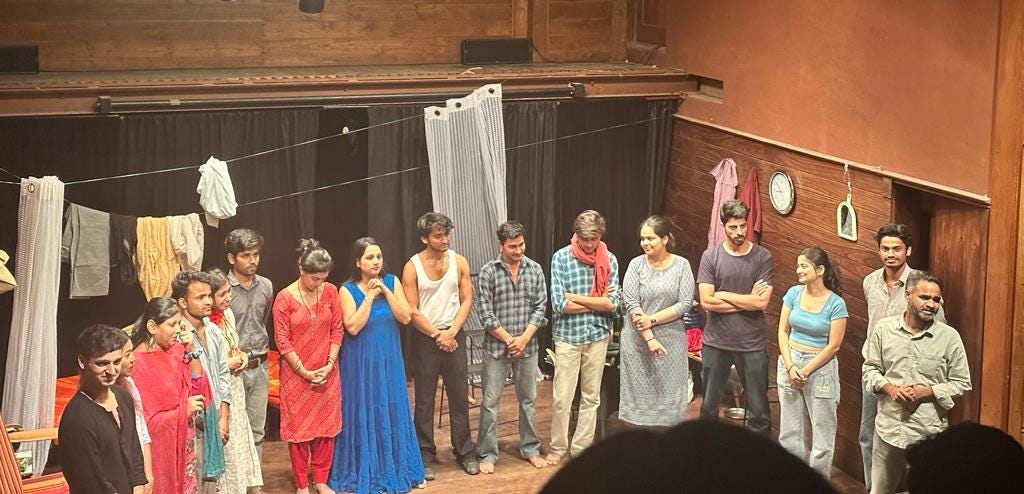I have always believed that theatre is a raw art form superior to cinema or Netflix shows. I had been regular to such events in Chennai and Bengaluru. In fact, Ranga Shankara is my favourite venue, where I have seen plays of the likes of Naseeruddin Shah. Somehow, I lost interest in theatre after moving to Delhi. This was rekindled yesterday.
My newfound interest in driving and an empty calendar on a Sunday led me to book tickets for the play — A Streetcar Named Desire at Akshara Theatre. It is a small venue with an open ground, an open theatre and a cosy yet uncomfortable indoor venue, probably meant for 100-150 people. The toilets are basic for a place at the heart of India’s political and intellectual capital.
It was a very bad decision to wear shorts to a venue plagued by mosquitoes, a particularly dangerous hazard in the opinion of Delhi Metro announcers warning people against dengue. Maybe the managers of Akshara Theatre did not get the memo. The seats inside were uncomfortable even for a casual luncheon with your college alumni, let alone a two-hour play. The seats were not even numbered.
Straightaway, I could sense that the acoustics at the venue were not great either. Don’t get me started on the limited parking space (Just 5-10), either. However, the venue manager was kind enough to mention that I could come early and take one of the limited slots.
The water bottle kept on each seat was the saving grace, so to speak. I harshly contradicted my friend when she called it a ‘cutu venue’ over WhatsApp. On top of this, the venue was right next to my ex’s workplace, the RML hospital. Only a stoic could have gulped so many challenges in expectation of a good evening.
A Streetcar Named Desire
The biggest pull was the name. ‘A Streetcar Named Desire’ is quite a famous play by Tennesse Williams in 1947. Being a non-Hindi speaker, I was quite amused by the idea of seeing an English play adopted into a language I probably don’t understand 100% (I would say 85% with some degree of confidence).
The Story
I hate the task of summarising a story without revealing spoilers. It takes too much mental effort. So I will share the BookMyShow description of the play.
“A Streetcar Named Desire" is a Hindi adaptation of Tennessee William’s iconic play into the Indian cultural context. The story revolves around " Sanskriti" A troubled woman from a traditional Indian family. She arrives to stay with her sister "Devika "and her rough-and-tumble husband "Dev".
Sanskriti struggles with mental health, cultural clashes, and her past secrets unfold against the backdrop of a rapidly changing Indian society.
Sanskriti’s fragile mental state and Dev’s aggressive behaviour lead to a dramatic clash, exploring themes of desire, delusion, and disintegration. The play delves into the complexities of human relationships and the consequences of suppressing painful truths.
Broadly, the play tries to capture how desire, if unfulfilled or uncontrolled by an individual, can lead to hopelessness and, eventually, madness. It also portrays how hopelessness sometimes forces people to accept their fate and feel safe in their misery. It is very easy to write such lines, but it is very hard to make someone feel it in their bones via acting or storytelling.
Quality of adoption
One of the most impressive things about the play was that it felt very Indian in its touch and feel. The rawness of domestic abuse and Stockholm syndrome rooted in the lower-class domestic wife was well portrayed by the Indianised character, Devika. Her rationalisation of domestic abuse and lack of alternatives made her look insane at the beginning. It’s also interesting to know that the Indianised names of the characters are chosen to fit in smoothly with the kind of dialogue the characters need to deliver.
Intensity of acting
Initially, the first two scenes didn’t seem very interesting. The acting appeared a bit plain. But I could later figure out that it was a gradual buildup to the denouement. Though it is not the director's or actors' fault, I felt that the play had too many extras that didn’t quite add value to the narrative. Or maybe they did in a certain way, but none of the side characters were memorable (apart from occasional quips). Only Dev, Sanskriti and Devika held the rapt attention of the audience.
Only one of the three, Sanskriti, made me feel she was deep into her role. I felt as if she had gone insane for real. Probably, the play was written for Sanskriti to shine.
Quality of Production
The transitions between scenes were the loose ends in the entire performance. In addition to this, the audio and lighting were a bit off due to the technical limitations of a venue built for the 1970s. Also, non-actors were visible via the door during certain scenes as I sat in the far left of the rows. Again, I blame the venue and not the director. More attention to detail and better infra would make it perfect.
Despite my critical remarks and the praise for acting, I still say that two hours of drama without a break was engaging. I was completely engrossed in the stories of these characters, and I waited for some sorta of conclusion to their dilemmas. I was truly impressed and felt that all the first-world problems I had were worth enduring.


